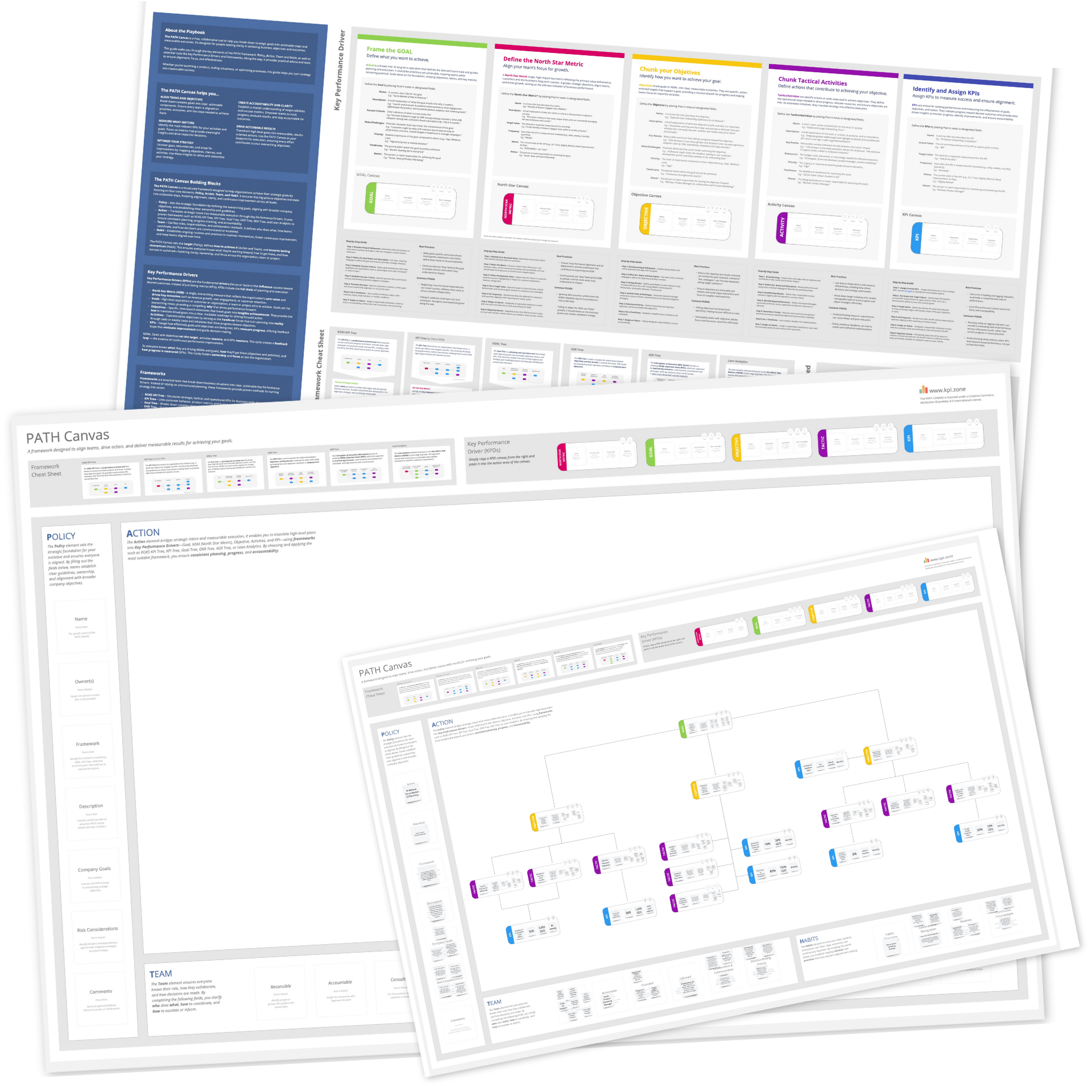Table of Contents
Tuesday. 9:01 AM.
We were two minutes into our weekly exec sync, and already it had begun.
"What’s the latest on sales qualified leads?"
"Wait—are we using your spreadsheet or the new dashboard?"
"Didn’t marketing say MQLs were up?"
I sat there watching the same old story unfold: different numbers, different formats, different stories. The update meeting had turned into a debate about data integrity instead of strategy. Again.
And here’s the thing: every single person in that room cared. But we were wasting our collective brainpower just trying to sync facts.
So we tried something different. We killed the weekly update call. And we built a shared KPI dashboard instead.
KPIs Aren’t Just Metrics. They’re Alignment Tools.
Most teams treat KPIs like scoreboards. But what if I told you they’re better used as compasses?
The right KPIs tell your team not just how they’re doing but whether everyone’s going in the same direction. They’re strategic alignment tools, not just performance trackers.
Done well, they:
- Make your priorities unmissable
- Give teams real-time feedback on what’s working
- Replace guesswork with clarity
But when KPIs are siloed or misaligned, it’s like everyone's rowing in a different direction.
Busy? Sure. Productive? Not even close.
Shared KPIs give leadership teams a common language. They let marketing, sales, product, and ops all see how their efforts stack up toward the same outcomes.
When KPIs align, meetings become about what to do, not what’s going on.
Why We Ditched the Update Meetings (And You Should Too)
Meetings aren’t evil. But they’re often overused.
A 2023 Atlassian survey of 5,000 knowledge workers found:
- 72% of meetings are viewed as ineffective
- 78% say too many meetings hurt their actual work
We saw it ourselves. Endless update meetings were burning hours each week.
The result? Low energy. Minimal decisions. Tons of repetition.
So we ran a test: what if we shifted to shared dashboards + async updates?
Here’s what we did:
- Built a live KPI dashboard visible to all leaders.
- Replaced weekly syncs with a "3-Minute Monday" update: one Zoom call, plus links to the dashboard.
- Reserved meetings only for decision-making and roadblock removal.
The result? A 40% drop in meeting hours and a massive jump in meeting quality.
People came in informed. And instead of debating numbers, we tackled strategy.
Your KPIs Should Work Harder Than Your Calendar
If you're relying on meetings to align your leadership team, you're solving the wrong problem.
Visibility shouldn’t require a Zoom link.
Shared KPI dashboards let everyone:
- See the same data, in the same format
- Track progress in real-time
- Spot issues early and discuss insights, not raw metrics
And when people have access to the same source of truth, alignment stops depending on meetings and starts depending on momentum.
Four Frameworks That Turn KPIs Into Alignment Machines
Looking for structure? These are the four frameworks we’ve seen work wonders for teams scaling fast.
1. The 4 Disciplines of Execution (4DX)
- Focus on a few Wildly Important Goals (WIGs)
- Define lead & lag KPIs for each goal
- Use a visible scoreboard everyone understands
- Hold short weekly check-ins to update the score and commit to next steps
If your scoreboard doesn’t answer that in 5 seconds, it’s not working hard enough.
2. North Star Metrics (NSM)
Every team needs a shared north. One metric that represents the core value you deliver.
Facebook? Monthly Active Users. Amazon? Customer Lifetime Value.
Pick yours. Make it visible. Make it count.
A good NSM is:
- Aligned to your mission
- Cross-functional in impact
- Measurable over time
3. Lean Analytics (One Metric That Matters)
Sometimes, you need radical focus.
Lean Analytics introduces the OMTM: One Metric That Matters.
It’s the only metric you care about more than anything else at a given time.
This isn't forever. But it forces clarity. At any moment, the entire team should know:
- What’s the #1 thing we’re trying to improve?
- Are we winning?
When priorities change, so does the OMTM. But never track 10 things when one matters most.
4. OKRs (Objectives and Key Results)
The classic.
- Set bold, qualitative Objectives
- Define 2–5 Key Results per objective (quantitative)
- Track progress openly and regularly
When done well, OKRs:
- Translate strategy into measurable targets
- Align cross-functional teams
- Replace guesswork with clarity
The best part? Shared visibility.
No one has to ask, "Are we on track?" — The dashboard already answered.
You can build and visualise your KPIs using my Path Canvas. It’s a great way to define, align, and map metrics across teams — before you ever open a spreadsheet. Plus, you'll get a detailed playbook on how to navigate different frameworks as a bonus.

The Meeting Isn’t Dead. But It’s Evolved.
Leadership check-ins aren’t disappearing. But their purpose is changing. We don’t need 60-minute status updates. We need 15-minute insight huddles.
Here’s a better rhythm:
- Async prep — Share dashboards and updates 24h before.
- Sync meetings — Use time to ask: Why is this off? What’s next?
- Post-meeting notes — Document actions, not just observations.
If no decisions are needed? Skip the meeting entirely.
Have each leader post a quick async update with:
- KPI trend (link to dashboard)
- Key insight or shift
- Help needed / offer to help
Suddenly, updates become interpretation. And meetings become decision accelerators.
Balance Strategy with Ops. The KPI Hierarchy.
Not all metrics are created equal. Some are strategic (outcomes). Others are operational (activities).
Great leadership teams track both.
Strategic KPIs: Big-picture, often lagging indicators. Revenue, NPS, market share.
Operational KPIs: Day-to-day drivers. Conversion rates, uptime, response time.
The key? Tie them together.
- Revenue depends on average deal size (Sales)
- Customer satisfaction depends on resolution time (Support)
- Time-to-market depends on deployment frequency (Engineering)
For a deeper dive on this topic, check out our full breakdown of Strategic vs. Operational KPIs on the KPI.zone blog.

Map it like this:
Company Goal → Team Outcome → Individual Metrics
Now everyone sees how their work ladders up to strategy.
No confusion. Just contribution.
The Payoff: What KPI-Driven Leadership Actually Delivers
Let’s be clear. This isn’t about "saving time", though that’s a nice bonus.
It’s about transforming how leadership works.
What you’ll gain:
- Transparency & Trust: Everyone sees the same data. No spin. No silos.
- Faster Decisions: Real-time dashboards = action before the next calendar slot.
- Fewer Meetings: Async updates replace most status calls. Live time = real talk.
- Aligned Execution at Scale: New teams plug into the same scoreboard. Focus stays sharp.
This is leadership without micromanagement. Alignment without overload.
And it scales.
TL;DR: Kill the Meeting. Share the Scoreboard.
If your leadership team is:
- Drowning in updates
- Debating which numbers are right
- Struggling to connect strategy to execution
Then your calendar isn’t the problem.
Your KPI system is.
Fix that, and you’ll:
- Align faster
- Decide smarter
- Move as one
Next step?
Pick one metric today. Share it in your team Slack. Link the dashboard. Ask one question:
"What can we do this week to move this number?"
Then do it again next Monday.
That’s how alignment starts.
And trust me — no one will miss the Monday meeting.
Let’s measure what matters. ✊



